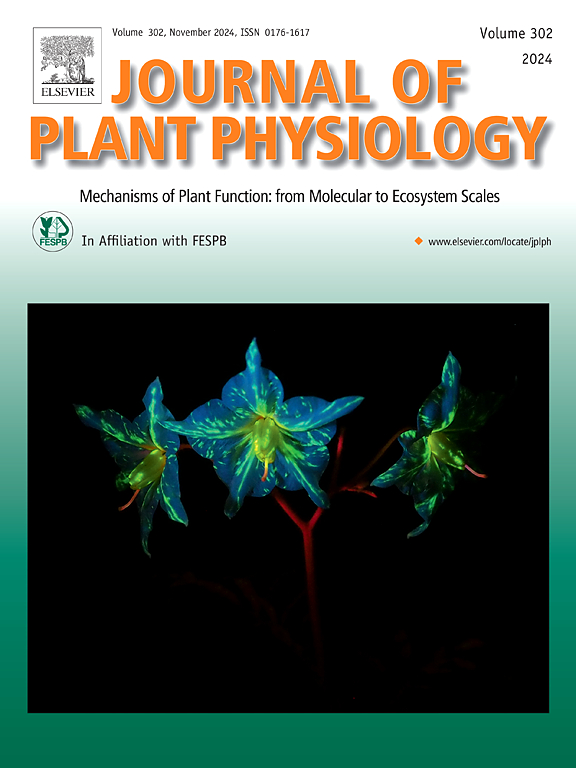中国樱桃MADS-box基因的鉴定及促进转基因拟南芥早花的CpMADS2过表达
IF 4.1
3区 生物学
Q1 PLANT SCIENCES
引用次数: 0
摘要
中国樱桃(Cerasus pseudocerasus Lindl.)“麻瑙红”是中国贵州省的一种独特品种,具有重要的营养和经济价值。在之前的研究中,我们观察到“麻瑙红”樱桃的开花异常现象。MADS-box基因家族在植物开花时间和花器官发育调控中起着关键作用。在这项研究中,我们鉴定了51个CpMADS基因。转录组分析显示,pi样基因CpMADS2在中国樱桃正常花(NF)和异常花(AF)中表达有显著差异。为了进一步研究CpMADS2的功能作用,我们从中国樱桃中克隆了CpMADS2。CpMADS2在拟南芥中的过表达比野生型开花更早。酵母双杂交(Y2H)实验和荧光素酶互补实验(LCA)证实CpMADS2与CpFT相互作用,提示CpMADS2可能通过与CpFT相互作用促进开花。本研究为进一步研究CpMADS2在中国樱桃异常开花中的调控作用提供了理论基础。本文章由计算机程序翻译,如有差异,请以英文原文为准。
Characterization of MADS-box genes in Chinese cherry and overexpression of CpMADS2 promoting early flowering in transgenic Arabidopsis
The Chinese cherry (Cerasus pseudocerasus Lindl.) cv. 'Manaohong', a distinctive cultivar indigenous to Guizhou Province, China, possesses significant nutritional and economic value. In our previous studies, we observed an abnormal flowering phenomenon in the 'Manaohong' cherry. The MADS-box gene family plays a pivotal role in regulating flowering time and the floral organs development in plants. In this study, we identified 51 CpMADS genes. Transcriptome analysis revealed that the PI-like gene CpMADS2 was significantly differentially expressed between normal flowers (NF) and abnormal flowers (AF) in Chinese cherry. To further investigate the functional role of CpMADS2, it was cloned from the Chinese cherry. Overexpression of CpMADS2 in Arabidopsis thaliana exhibited earlier flowering compared to wild-type. Yeast two-hybrid (Y2H) assay and luciferase complementation assay (LCA) confirmed that CpMADS2 interacts with the CpFT, suggesting that CpMADS2 may promotes flowering by interacting with CpFT. This study provides a theoretical foundation for further research on the role of CpMADS2 in regulating abnormal flowering in Chinese cherry.
求助全文
通过发布文献求助,成功后即可免费获取论文全文。
去求助
来源期刊

Journal of plant physiology
生物-植物科学
CiteScore
7.20
自引率
4.70%
发文量
196
审稿时长
32 days
期刊介绍:
The Journal of Plant Physiology is a broad-spectrum journal that welcomes high-quality submissions in all major areas of plant physiology, including plant biochemistry, functional biotechnology, computational and synthetic plant biology, growth and development, photosynthesis and respiration, transport and translocation, plant-microbe interactions, biotic and abiotic stress. Studies are welcome at all levels of integration ranging from molecules and cells to organisms and their environments and are expected to use state-of-the-art methodologies. Pure gene expression studies are not within the focus of our journal. To be considered for publication, papers must significantly contribute to the mechanistic understanding of physiological processes, and not be merely descriptive, or confirmatory of previous results. We encourage the submission of papers that explore the physiology of non-model as well as accepted model species and those that bridge basic and applied research. For instance, studies on agricultural plants that show new physiological mechanisms to improve agricultural efficiency are welcome. Studies performed under uncontrolled situations (e.g. field conditions) not providing mechanistic insight will not be considered for publication.
The Journal of Plant Physiology publishes several types of articles: Original Research Articles, Reviews, Perspectives Articles, and Short Communications. Reviews and Perspectives will be solicited by the Editors; unsolicited reviews are also welcome but only from authors with a strong track record in the field of the review. Original research papers comprise the majority of published contributions.
 求助内容:
求助内容: 应助结果提醒方式:
应助结果提醒方式:


